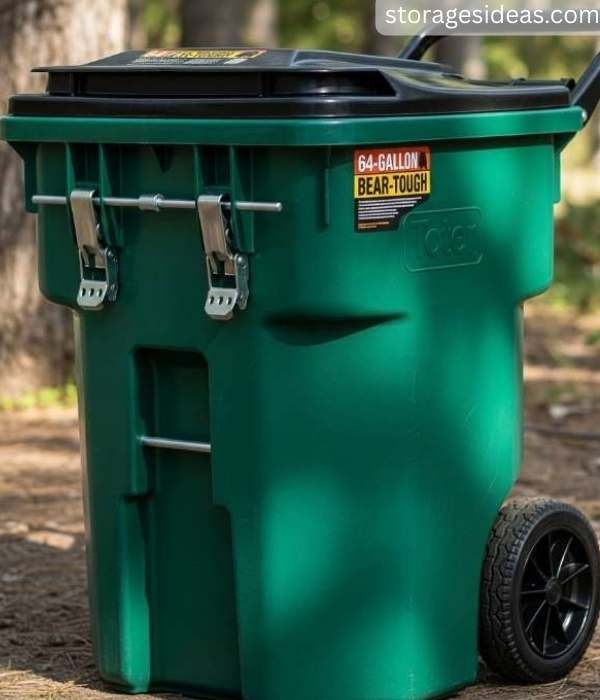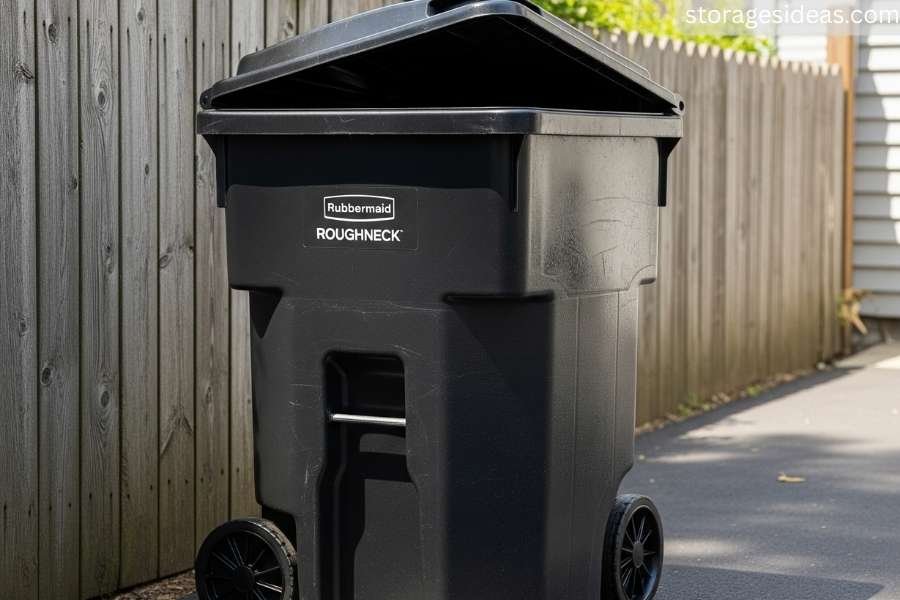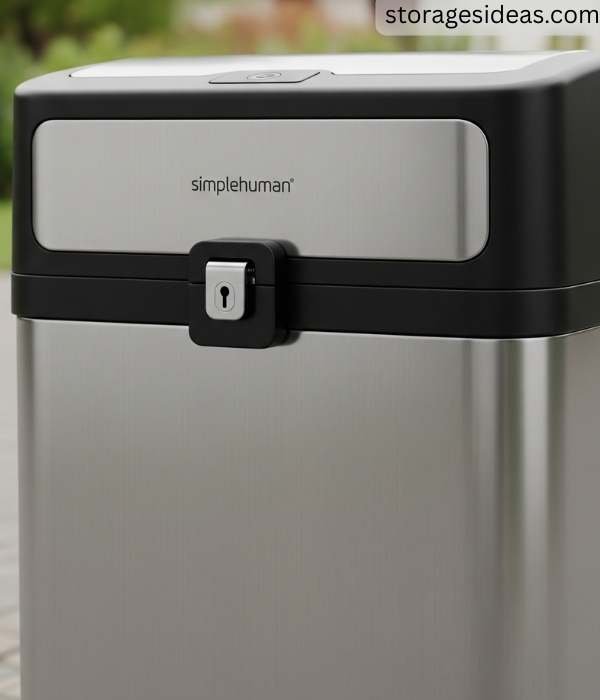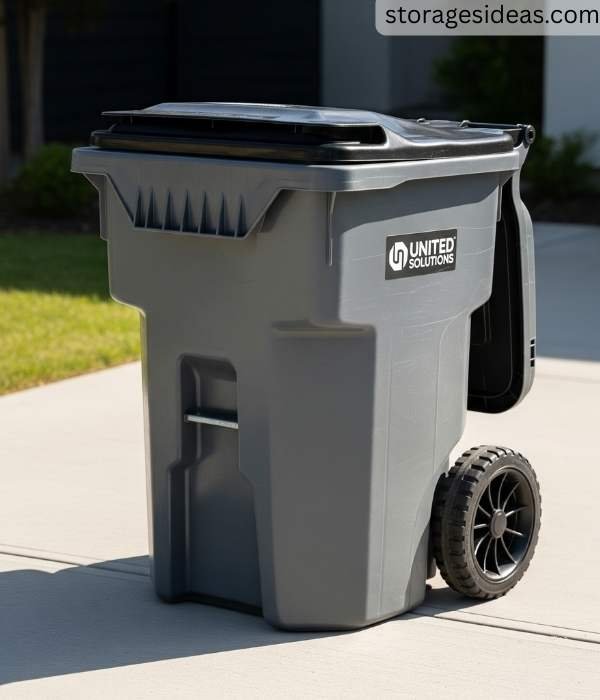Keeping the outside of my house clean and free from trash blowing around has always been important to me. But anyone who has dealt with curious raccoons, nosy dogs, or just strong winds knows how frustrating it can be to find garbage scattered across the yard. That’s why choosing the right outdoor trash can isn’t just about tossing waste; it’s about security, durability, and peace of mind.
In this blog, I’ll walk you through:
- Why outdoor trash cans matter for every house.
- Key features I always look for in a reliable trash can.
- Common mistakes homeowners make when buying outdoor trash cans.
- My top 5 recommendations that really work.
- How to maintain and extend the life of your outdoor trash cans.
- Tips for choosing the right outdoor trash can.
- FAQs to clear up common doubts.
Let’s dive in.
In This Guide, I’ll Cover
ToggleWhy Outdoor Trash Cans Matter for Every House
For me, an outdoor trash can isn’t just a container. It’s the first line of defense against mess, pests, and even neighborhood eyesores. Without a proper one, I’ve seen trash bags ripped open overnight by cats, crows, or worse, rats.
A good trash can keeps waste sealed, reduces odor, and prevents animals from feasting in my yard. Plus, it makes trash day less stressful when I don’t have to worry about dragging ripped bags to the curb. If you live in a windy area, I also recommend checking my guide on how to secure outdoor trash cans in windy conditions.
Features I Always Look for in an Outdoor Trash Can
When I shop for a trash can, I keep these must-haves in mind:
- Durability: I want heavy-duty plastic or metal that doesn’t crack under the sun or buckle in winter.
- Secure Lid: A tight-fitting lid keeps out animals and locks in odor.
- Size: I usually go for 32–64 gallons, depending on household needs.
- Mobility: Wheels and a handle make hauling it to the curb so much easier.
- Weather Resistance: I need something that won’t tip in strong winds.
If you’re confused about choosing between materials, check out my comparison on stainless steel vs plastic trash cans.
Common Mistakes People Make When Choosing Trash Cans
I’ve noticed many homeowners make avoidable mistakes when picking an outdoor trash can. Here’s a deeper look at what to watch out for:
- Going Too Small: Many underestimate how much trash their household produces. A 20-gallon can may seem fine initially, but overflow happens in just a day or two. I’ve learned that it’s better to have a slightly larger can than struggle with constant overflows.
- Ignoring Lid Quality: A flimsy or loose lid is basically an invitation for raccoons, dogs, or even neighborhood cats to raid your trash. I once had a flimsy lid ripped off overnight, and my trash was scattered across the yard—lesson learned! Always look for locking or heavy-duty lids.
- Forgetting About Wheels: Some people buy a large can but don’t think about mobility. Dragging a heavy, full bin to the curb can be exhausting and even dangerous on sloped driveways. Wheels and sturdy handles make a huge difference.
- Choosing Light Plastic or Cheap Materials: Budget bins may save money upfront, but often crack in extreme weather, warp in heat, or fade over time. Investing in high-quality resin or metal ensures longevity.
- Not Considering Placement: Placing your trash can in a windy or exposed area increases the chances of tipping or spilling. A shaded or semi-sheltered location helps keep it stable and protects it from UV damage.
- Overlooking Odor Control: Some cans trap odor poorly. Without ventilation or a sealed lid, foul smells can linger and attract pests. Consider bins with tight-fitting lids or those designed to reduce odor.
- Buying Without Checking Local Regulations: Certain municipalities have specific requirements for outdoor trash cans, including size, color, or lid design. Ignoring these can result in fines or needing a replacement.
By avoiding these mistakes, you not only protect your trash but also save time, money, and frustration.
5 Best Outdoor Trash Cans for House (My Picks)
Here are my personal picks that stand out for durability, functionality, and animal-proof design:
1. Toter 64-Gallon Bear-Tough Trash Can

If there’s a gold standard for animal-proof trash cans, the Toter Bear-Tough is it. Built from heavy-duty, double-walled resin, this can is literally certified bear-resistant by the Interagency Grizzly Bear Committee. That means it’s strong enough to handle much smaller critters like raccoons, possums, and dogs.
- Build Quality: Industrial-strength resin, reinforced handles, UV-resistant to prevent fading or cracking.
- Ease of Use: Despite its heavy build, the large wheels and ergonomic handle make it surprisingly easy to drag to the curb.
- Capacity: At 64 gallons, it easily holds a week’s worth of trash for a family of 4–5.
- Maintenance: The smooth interior surface makes cleaning easier—odors don’t cling as much.
- Pros: Virtually indestructible, lockable lid, excellent for animal-heavy neighborhoods.
- Cons: Expensive, takes up more space, overkill if animals aren’t an issue.
- Best For: Families in rural or suburban areas where wildlife is a constant problem.
2. Rubbermaid Roughneck Wheeled Trash Can (32-Gallon)

The Rubbermaid Roughneck is my go-to for smaller households or those who don’t need something massive. It’s durable without being overly heavy, and its snap-fit lid keeps animals at bay; at least the smaller ones.
- Build Quality: Made with impact-resistant polyethylene that doesn’t crack easily, even in cold weather.
- Ease of Use: Lightweight, easy to maneuver, especially on paved driveways.
- Capacity: 32 gallons—ideal for couples or families of 2–3 people.
- Maintenance: The Resin material resists stains, and the design keeps water from pooling on the lid.
- Pros: Affordable, compact, durable, fits in smaller yards.
- Cons: Too small for larger families, the lid may not withstand aggressive raccoons.
- Best For: Small households, budget-conscious buyers, or as a secondary yard-waste bin.
3. Simplehuman Outdoor Trash Can with Locking Lid (45-Liter / ~12 Gallons)

While smaller than the others, this Simplehuman model wins points for sleek design and functionality. It’s perfect for those who keep their bin in a visible spot (like a patio or porch) and don’t want it to look like an eyesore.
- Build Quality: Powder-coated stainless steel or heavy-duty plastic, both resistant to rust and corrosion.
- Ease of Use: Features a locking lid with a steel foot pedal for hands-free use.
- Capacity: 45 liters (roughly 12 gallons)—better suited as a stylish supplemental bin.
- Maintenance: Fingerprint-proof coating and removable inner liner make it easy to clean.
- Pros: Modern design, locking lid, odor control, smaller footprint.
- Cons: Small capacity, higher price compared to basic bins.
- Best For: Homeowners who care about aesthetics, or as a designated trash can for patios, garages, or outdoor kitchens.
4. Behrens Galvanized Steel Can (20–31 Gallons)

This one is a classic, the kind of metal you’ve probably seen in old cartoons. But don’t let its vintage look fool you. It’s still one of the most effective ways to keep pests out, especially since animals can’t chew through galvanized steel.
- Build Quality: Made from 100% galvanized steel, rust-resistant, fire-safe, and virtually chew-proof.
- Ease of Use: Lightweight for a metal can, though the lack of wheels makes it harder to move when full.
- Capacity: Available in 20, 24, or 31 gallons. Great for small households or as a secondary bin for compost, pet food, or yard waste.
- Maintenance: Hose it out occasionally, and it’s good as new. Metal doesn’t absorb odors like plastic.
- Pros: Durable, classic look, animal-proof, multipurpose.
- Cons: No wheels, lid can be noisy and may blow off in heavy winds unless weighted.
- Best For: Traditionalists, homeowners with small-to-medium trash output, or anyone wanting a tough, chew-resistant bin.
5. United Solutions Heavy-Duty Outdoor Wheeled Trash Can (64-Gallon)

This is a solid, affordable alternative to pricier animal-proof cans. While it’s not bear-certified, it’s sturdy enough for daily use in most suburban households.
- Build Quality: Thick plastic resin that resists cracking in the sun and cold.
- Ease of Use: Comes with durable wheels and a reinforced handle for easy rolling.
- Capacity: 64 gallons—plenty of room for families with larger weekly waste output.
- Maintenance: Smooth interior makes washing it down quick and simple.
- Pros: Large size, affordable compared to premium models, and weather-resistant.
- Cons: Lid doesn’t lock as securely as higher-end options, may need bungees for animal-heavy areas.
- Best For: Families needing a spacious, budget-friendly bin without advanced animal-proofing.
If you’re looking for more stylish picks, you can also explore my list of decorative outdoor trash cans.
How I Maintain My Outdoor Trash Can
Even the best trash can won’t last if you don’t care for it properly. Over the years, I’ve developed a simple routine that keeps my bins clean, odor-free, and functional for years:
- Regular Rinsing: I rinse my trash cans with a hose at least once a month. For deeper cleaning, I sometimes use a mild soap solution.
- Odor Management: Baking soda, vinegar, or specialized trash can deodorizers work wonders. Sprinkling a little baking soda at the bottom helps absorb foul smells.
- Proper Placement: I store my cans in a shaded area to reduce sun damage and prevent the plastic from warping or fading.
- Double-Bagging Messy Waste: Raw meat scraps or kitchen waste can leak and create odors. I double-bag these items before placing them in the bin.
- Checking for Wear and Tear: Every few months, I inspect my bins for cracks, broken lids, or loose wheels. Prompt maintenance or replacement prevents bigger problems down the road.
- Seasonal Care: In winter, I make sure the lids aren’t frozen shut by occasionally spraying a little cooking oil or silicone lubricant on hinges. In summer, I rinse more often to combat heat and odor build-up.
- Weekly Quick Clean: Even without heavy washing, I give the can a quick rinse and wipe-down weekly to prevent sticky residues and bacterial growth.
Tips for Choosing the Right Outdoor Trash Can
- Assess Your Household Size and Trash Output – Bigger households need larger bins to avoid overflow.
- Consider Wildlife in Your Area – For raccoons or possums, choose animal-proof cans.
- Think About Mobility – Wheels and reinforced handles make hauling easy.
- Check Material Quality – Heavy-duty resin or galvanized steel resists cracking and rust.
- Prioritize Lid Design – Locking lids or foot pedals are ideal.
- Consider Multi-Purpose Options – Some bins allow sorting recyclables or compost.
- Don’t Forget Local Regulations – Verify size and color requirements.
Final Thoughts
From personal experience, a good outdoor trash can saves time, stress, and cleanup. Whether you’re dealing with raccoons or are tired of replacing cracked plastic bins, upgrading to a durable, animal-proof option is worth it.
My favorites, like the Toter Bear-Tough and Rubbermaid Roughneck, have proven to be long-term solutions. At the end of the day, the right trash can doesn’t just hold garbage; it keeps your home cleaner, safer, and more comfortable.
FAQs About Outdoor Trash Cans
Q: How big should my outdoor trash can be?
A: For a family of 3–4, I recommend at least 45–64 gallons. Larger families may need 64 gallons or more.
Q: How do I prevent animals from opening my trash can?
A: Invest in a heavy-duty can with a locking lid. Positioning it against a fence or wall adds extra protection.
Q: Is plastic or metal better for outdoor bins?
A: Metal is chew-proof and fire-safe, but can rust over time. Heavy-duty plastic is durable, lightweight, and UV-resistant.
Q: How do I manage odors?
A: Sprinkle baking soda, rinse monthly, and double-bag food waste. Some bins have built-in odor control.
Q: Can I leave my trash can outside year-round?
A: Yes, but store it in a shaded area to prevent sun and weather damage.
Q: Are wheels necessary?
A: Absolutely. Even smaller cans can be heavy when full.
Q: How often should I clean my trash can?
A: At least once a month, more often if it contains food waste.

